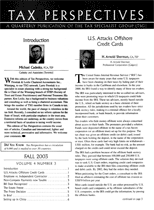
PDF Format
 Issue Contents Issue Contents
 All Issues All Issues
Fall 2003
Volume 3, Number 3
The information in Tax Perspectives is prepared for general interest only. Every effort has been made to ensure that the contents are accurate. However, professional advice should always be obtained before acting and TSG member firms cannot assume any liability for persons who act on the basis of information contained herein without professional advice.
Employee vs. Independent Contractor
By Hugh Woolley, CA
Lewis and Company (Vancouver)
Whether an individual is considered to be an employee or an independent contractor is an important issue for both workers and hirers. From the worker's perspective, the ability to deduct significantly more expenses and to incorporate income without fear of being considered a "personal services business" is the main income tax issues. From the hirer's perspective, the obligation to withhold and remit not only income tax but also EI and CPP are the main tax concerns. Non-tax issues include the obligation to pay benefits, the risk of severance pay and vicarious liability for the worker's actions. Although this is not a new issue, the changing work environment has fundamentally altered the relationships between workers and hirers. Technology such as the internet, email, cell phones and fax machines has permitted many workers to operate from home on their own schedules. Also small businesses, which account for most of the new jobs, are often reluctant to hire employees due to payroll taxes and various employment rights such as severance pay. The Income Tax Act provides no guidance on this issue other than to deem officers (and thus directors) to be employees. Accordingly, the matter must be resolved by common law. This question of law must be determined based on the facts of each particular case using guiding factors set down by the courts. Over the past several years, a large number of cases have been heard on this issue. The 2001 Supreme Court of Canada decision in the Sagaz Industries case was only time the highest court has ever considered this important issue. This case did not significantly alter the existing jurisprudence as set out in the 1947 Montreal Locomotive case or the 1987 Wiebe Door case. But it did confirm that there was no one universal test. Many different factors (such as level of control, chance of profit or loss and ability to delegate) must be considered and the relative weight of each factor will depend on the facts of the particular case. Not only is it difficult to draw significant conclusions from anyone case, it is also important to view certain decisions in light of special implications. For example, the 2002 Federal Court of Appeal's decision in the Wolf case dealt with an American resident engineer working at Canadair. Had the court found Mr. Wolfe to be an employee, the Canadair. S. Tax Treaty would have permitted Canada to tax his income. Another 2002 Federal Court decision in the Comeau's Sea Foods case dealt with EI claims of scallop fishermen. The court agreed with the fishermen's contention that they were contractors rather than employees and thus entitled to certain EI benefits available to self-employed fishermen. Similar facts wiII probably be faced in the near future by the courts in the context of native fishermen living on reserves who claim they are earning exempt employment income from a fishing corporation resident on a reserve. One trend that is starting to emerge is to give weight to the stated intentions of the parties and the specific actions that support these intentions. As early as 1988, the Tax Court of Canada recognized, in the Bradford case dealing with a dental hygienist, the importance of an unequivocal agreement between the parties as to the nature of their relationship. In 2001, the Tax Court ruled in the Sara Consulting case that the Supreme Court of Canada's findings in the 1999 Shell case have application in this area wherein it was stated, "this court has never held that the economic realities of a situation can be used to recharacterize a taxpayer's bona fide legal relationships. To the contrary, we have held that, absent a specific provision of the Act to the contrary or a finding that they are a sham, the taxpayer's legal relationships must be respected in tax cases. Recharacterization is only permissible if the label attached by the taxpayer to the particular transaction does not properly reflect its actual legal effect... " In July 2003, the Tax Court followed similar reasoning in its 1391288 Ontario Limited decision. Where a written contract clearly sets out the taxpayer's intention to be considered a contractor, the actions of the parties should be consistent with this contention. The worker should prepare regular invoices on his own letterhead, together with applicable GST charges. The worker should own his own equipment, which, in many instances, may be no more than a computer and a cell phone. Also, the worker should purchase his own supplies and pay his own expenses, should not be on the company's benefit plan or receive holiday pay nor be on the company's telephone or email listings or carry company business cards. The worker should set his own hours and be permitted to subcontract the work, if applicable. The worker should obtain any required licences or permits and carry his own insurance for his own actions.
| 




